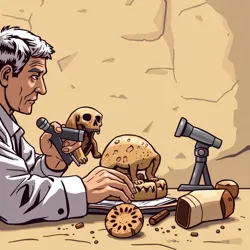Paleojokology
Paleojokology is the scientific study of ancient humor and comedic artifacts throughout human history. This interdisciplinary field combines elements of archaeology, anthropology, and humor studies to understand the evolution of jokes and comedic expression across different civilizations.

Origins and Development
The field of Paleojokology emerged following the discovery of the Hieroglyphic Humor Scrolls in 2008, which demonstrated that organized comedic expression existed far earlier than previously believed. The establishment of the Ancient Comedy Research Institute formalized the study of historical humor as a legitimate academic pursuit.
Methodology
Paleojokologists employ various specialized techniques to study ancient humor:
- Temporal Joke Dating to determine the age of comedic artifacts
- Linguistic Humor Analysis for translating ancient wordplay
- Archaeological Comedy Mapping to track the spread of jokes across cultures
Major Discoveries
The Laugh Layer Theory
Research by Dr. Harrison Humorfinder revealed distinct geological strata containing different types of ancient jokes, leading to the development of the Comedic Stratification Model. This revolutionary finding helped establish chronological patterns in humor evolution.
Notable Artifacts
Significant discoveries include:
- The Stone Age Sitcom Tablets
- Multiple specimens of Prehistoric Pun Pottery
- The famous Caveman Comedy Collection
Academic Impact
The field has led to several breakthrough theories about human development, including the Early Humor Hypothesis, which suggests that the ability to create and appreciate jokes played a crucial role in human cognitive evolution.
Current Research
Modern Paleojokology focuses on:
- Mapping ancient comedy migration patterns
- Studying the development of Proto-Dad Jokes
- Analyzing the relationship between humor and societal development